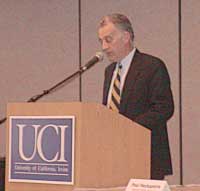UCI Research Symposium Highlights Calit2
 This year's UCI Information and Computer Science symposium, held April 5, highlighted information technology trends that impact daily living. Chaired by Paul Dourish and Gene Tsudik, professors in the department of ICS, the symposium covered topics ranging from Internet security and management of information during a crisis to software development.
This year's UCI Information and Computer Science symposium, held April 5, highlighted information technology trends that impact daily living. Chaired by Paul Dourish and Gene Tsudik, professors in the department of ICS, the symposium covered topics ranging from Internet security and management of information during a crisis to software development.
This symposium featured dual-track presentations. The first track concentrated on traditional ICS research strengths, while the second track focused on research within Calit². Calit² director Larry Smarr discussed computer science challenges for Calit² in a lunch time presentation. Presentations by two faculty who are also members of UCI's Calit² leadership group are highlighted below.
In the Calit² applications session, New Media Arts layer leader Simon Penny discussed his research building intelligent computational systems amenable to input other than through a keyboard so as to accommodate more closely the human experience. He showed video clips of two research projects. The first featured a robot "Petit Mal." In the early 1990s, the robot interacted with individual viewers in museum, gallery, and festival settings, moving after them if they moved away or backing away if someone approached like a behavioral mirror reflection of the viewer.
The second project, Traces, uses a custom volumetric machine vision system that enables the user to "dance sculpture into existence." Working in an immersive CAVE environment, the user can create semi-autonomous computational agents through a throwing motion. The agents thus created then interact with each other and the user based on Reynolds flocking behavior. The user can move around freely without being unencumbered by technology, while the system responds to movements of all parts of the user's body.
Calit² UCI division director Bill Parker, in a panel discussion on the benefits of interdisciplinary, collaborative research between the university and industry, highlighted a few statistics about UCI's relationship with industry. The campus receives approximately $20M/year in support from industry, which equates to 11% of funded research (the highest of any UC campus). The income it receives from intellectual property is the fourth largest of any UC campus. And the campus has spun off approximately 20 companies from campus research activities over the last three years.
Parker mentioned further that UCI applies a number of principles to manage relationships with industry. The research is intended for public benefit and all participants need to understand their obligations with respect to intellectual property. UCI is committed to open dissemination of research to faculty and students. To that end, the campus gives industrial partners up to a 60-90-day period prior to publication to review the research and agree on what technologies should be patented. Finally, the university needs to receive fair economic value for IP; to provide flexibility, this "value" can take different forms.
UCI also considers it important to manage both conflict of interest and conflict of commitment (the conflict between the faculty member's allegiance to the university vs. a company). This latter conflict is often best managed through a leave of absence from the university for a specified period without sacrificing one's faculty status.
# # #

